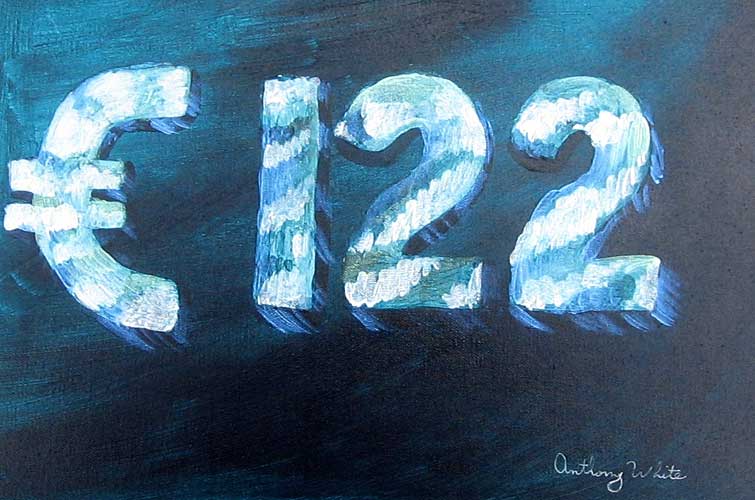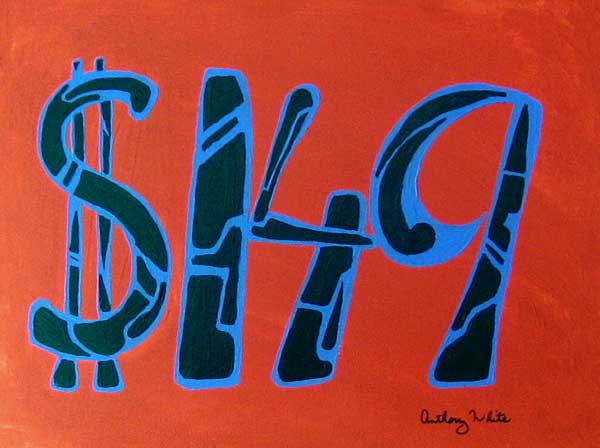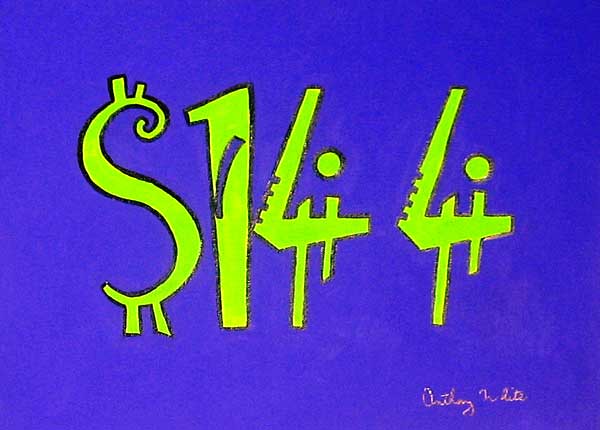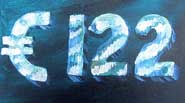
The Money Series
I had my first serious exposure to art while in university studying for my undergraduate economics degree. My university required me to have two “fine art” courses in order to complete my degree. The thinking behind this was that by studying art you will be a more rounded person and would allow you to look at tasks in a different light. Confronted with the extraordinarily scary prospect of actually “making” art in those fine art courses, I enrolled in two art history courses. One was a history of photography from its invention to WWII and the other was an introduction to modern art (vaguely considered 20th century art from just prior to the turn of the centry to the end of WWII).

My modern art history professor, straight out of teaching at NYU, instilled in me an appreciation for modernist, conceptual and “pop” art. We started our review of history in the late 1800’s by considering impressionist artists as Paul Cezanne, Georges Seurat, Vincent Van Gogh, Paul Gauguin and Auguste Rodin. From that footing, we built into modernist art by artists such as Georges Braque, Pablo Picasso, Vasily Kandinksy, Henri Matisse, Umberto Boccioni, Marcel Duchamp, Georgia O’Keefe and Salvador Dali among many others. We considered expressionism, cubism, surrealism, dada and futurism which are considered the forerunners to post-modern and conceptual art. At the time, I had never seen a real “collection” of art in “real life”, all that I learned was out of my very colourful text books. But I was hooked. I think that modern art history course was one of the best courses in my undergraduate degree and gave me an appreciation of art which I don’t think I would have achieved had I not been “forced” into those fine art courses. On the other hand, the economic theories that I was taught exist in my mind as a muddled group of little charts and formulae.
After graduation I was lucky enough to travel and actually see some of these works of art up close. I visited museums in London, Paris, Barcelona, Vienna, Berlin and New York, and as much as I couldn’t believe it, going to see pieces of art was often a highlight of these city trips. My favourite modern art museum is the Tate Modern in London followed by the Museum of Modern Art (MoMA) in New York. My favourite works of art include Van Gogh’s Sunflowers found in the National Gallery in London, some of Kandinsky’s work, Piccaso’s cubist period and some modernist sculptures like Boccioni’s Unique Forms of Continuity in Space and Marcel Duchamp’s Fountain. If you click on that last link, you’ll see Duchamp’s Fountain to be a urinal which is not connected to a pipe. The “fountain”, if you will, is aimed directly at the viewer. I still remember the realization when I first saw this piece – wait a second, if you piss in there you’ll hit your feet! Or as the Tate Modern more eloquently puts it – “(Fountain) epitomises the assault on convention and good taste for which (Duchamp) and the Dada movement are best known.” The reason why I enjoyed that particular piece was because I clearly remember my professor talking about the piece and saying essentially that Duchamp had tried to enter it into an exhibition in Paris in 1917 which was set up specifically to allow all independent artist to showcase their modernist art. When Duchamp tried to get the Fountain into the exhibit, it was rejected because “it was not art”. And this rejection was coming from other artists who had already had almost twenty years worth of modern art experience. The fact that it did not conform to their tastes allowed these artist to reject Duchamp. That was one of my main lessons from that art history class, art has many different definitions and it really is in the eye of the beholder. I enjoy modernist art and yet I understand that others enjoy realistic landscapes, others enjoy impressionism and others enjoy photography, however, my definition of art encompasses all of these artistic avenues.

A few months ago I came across The Money Series by Anthony White via a financial blog I frequent. The Money Series is simply a series of paintings of denominations of money. Anthony paints four currencies, Australian dollars (Anthony lives in a small town in Australia), U.S. dollars, Euros and British pounds. He paints, for example, the US$10 on a canvas and then sells that painting for US$10, so what you see is what you pay. The payment includes shipping to anywhere in the world and all taxes. Anthony only paints in sequence – so he’ll paint the US$10 and then wait until it sells and then paints and sells the US$11. He does not sell out of order, although anyone can reserve a “favourite number”. From the beginning, I enjoyed the ‘Money Art’ concept on a number of levels. First of all, Anthony has a financial background as he used to be a “stock broker” but quit to pursue his art. Second, what he is doing is essentially selling you a price tag, which appeals to me as a concept in that I think a lot of people who claim to appreciate art, appreciate ‘expensive’ art, in essence appreciating something that others already appreciate. Third, is his catch phrase/slogan on the front of his website: “Manufacturing Perceived Needs”, which of course is exactly what all art is.
For the artist, art may be a representation of their own psyche. In Anthony’s case, it is likely an extension of his desire to quit his financial services job, move to a small town in Northern Australia and paint. When I purchased one of Anthony’s paintings however, I purchased a conversation piece, which is what I think good art should be. I currently have the US$140 piece hanging on my wall. When someone says “what is it?”, I can say “It’s $140, exactly what it’s worth”. Sure you or anyone “could” paint numbers in a sequence as well, but would that be the same when you know you are copying someone somewhere? The Money Series is also a mild rebuke of the conservative idea of art – the one when you go to a gallery, look at something pretty (or not) purchase it and bring it home. I purchased a piece of art from an artist living across the world – receiving the package with its Australian postmarks and removing the piece from its bubblewrap was part of the artistic experience. There is also an active secondary market for The Money Series, which you can check out on Anthony’s webpage. The US$5 is currently selling on eBay for US$385 and the set of #1’s sold for A$4000. I purchased my $140 painting about a month ago and Anthony is currently on $157.

The final thing that attracted me to The Money Series was a bit of research I did on Anthony. I googled his name and did a bit of checking to see what others were saying. Initially I found a wikipedia entry, but when I went back a month later – no wikipedia entry (this could be another R4NT article). His wikipedia entry had been deleted. So I checked in the deletion record to see why the entry was removed. With typical wikipedia authoritarianism, The Money Series had been judged by the guardians of wikipedia to not be art. A few quotes from the deletion log: “Delete – notability not established”, “Delete, nonnotable per artist guidelines” and one extremely interesting comment in which an “RGTraynor” exhibited closed-mindedness so typical of wikipedia and called it “alleged art” and then followed up with this quote: “My ‘credentials’ are that I have eyes and discretion, and scrawling numbers on construction paper is something kindergarden kids do before nap time; we don’t hang those up in art galleries either.”
Of course, RGTraynor’s rebuke is exactly off the mark. If a broken urinal by Duchamp, or a painting of a Campbell soup can by Andy Warhol or splatters of paint by Jackson Pollock are art, paintings of amounts of money can be art. What RGTraynor’s problem is of course, is that Anthony White is not yet famous (in his/her concept of fame). And if you are not famous then you can not be an artist, or at least can not be an artist that deserves a page on wikipedia beside such banalities as an article on Britney Spears with 86 footnotes. The irony of an artist deleted from the people’s encyclopedia, a treasure trove of non-mainstream thought because his work “was not art”, is similar to what Duchamp faced 90 years ago. That rejection cemented my decision to purchase the US$140 painting. Any painting which could bring such loathing from someone such as RGTraynor must indeed be art.
More from MaxPower:
-

It’s Shocking
The BCAA survey found that “50% of BC drivers have reduced the amount of driving they do in an average week to compensate for higher fuel prices”.
-

Motorcycles
The baffles on his muffler had to be removed as it sounded like a jet was taking off down the street. This was probably exactly the effect he was going for, extreme annoyance..
-

Pains, Trains and Other Disasters
…These people often only have the experience of taking inter-city trains and compared to commuter trains it is like comparing driving a car to riding a horse in the rain, and the horse has a broken leg, and its cold outside, and the horse is dead…
-

Attack of the Wanna-Be Athletic Superstars
…I took this opportunity to surreptitiously unscrew the top of his water and knock it over, ending his drinking, when he got back he looked lost as he sat down in a puddle of water…
-

The Collapse of Capitalism?
..People who have lost their savings in the Enron collapse had put all of their cash into Enron and never invested in any other companies. Its called diversifying baby, spread the risk out, putting all you financial eggs in one basket is akin to committing economic suicide.
-

Cancer and You
You think we have starvation problems now, wait till the food gestapo starts kicking over bowls of rice in developing countries. Hey China and India – all 2.2 billion of you, stop eating rice it’ll give you cancer. Hey Italy don’t you know noodles will kill you?
Other recent features:
-

Sónar 2010 – Barcelona, Spain
The festival attracts a lot of outsiders, but the Mediterranean, Spanish and more specifically Catalan nature of the people makes the festival what it is. Catalan people are passionate and this passion is infectious. The atmosphere is electric in Barcelona as a city and heightened by music and intoxicants at Sónar.
-

Summer Party Naval Styles at Seven RestoLounge
Oysters, like wine are affected by terroir and these Miyagi’s flavor profiles ranged with one showing a cleaner, almost tropical profile and the other being more salty, marine driven. As I was devouring the seemingly endless plates put in front of us, I sipped on a glass of fine sauvignon blanc.
-

R4NT Radio March 2010
R4NT Radio March 2010 um wow it’s been far too long since the last edition edition, featuring: Hector Hernandez, The Infesticons, Blockhead, Gramatik, Emika, Thunderheist, Parov Stelar, Eddy Meets Yannah, Anti-Pop Consortium, The Slew, Lighterthief, Andreya Triana, Parasyte Woman, Mathon, Venetian Snares, and Funki Porcini.
-

O Restaurant & Lounge revisited
Calgary has a diverse set of urban communities, most of which have the ubiquitous strip mall watering hole. In the South West community of Marda Loop, a reinvention of this paradigm has been established.
-

Predictions 2010.. and beyond!
So 2010 eh? Almost but not quite (no year zero they say) another decade? It seems like just yesterday that the world was waiting for Y2K. R4NT started publishing in March 2001, so we’re not quite 10 years old yet, but in internet years we are already a senior citizen.
-

Invictus
No matter what, the reality of Nelson Mandela is something that deserves screen time. Should this film even remotely intrigue the masses to take interest in this figure, the world would likely benefit greatly from it.


